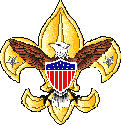| MERIT BADGES |
|
|
|
|
| Note: Eagle Required are in Italics |
"A"
American
Business
American Culture
American Heritage
American Labor
Animal Science
Archaeology
Archery
Architecture
Art
Astronomy
Athletics
Atomic Energy
Auto Mechanics
Aviation
"B"
Backpacking
Basketry
Bird Study
Bugling
"C"
Camping
Canoeing
Chemistry
Cinematography
Citizenship
Community*
Citizenship Nation*
Citizenship World*
Climbing
Coin Collecting
Collections
Communications*
Computers
Cooking
Crime Prevention
Cycling*
"D"
Dentistry
Disability Awareness
Dog Care
Drafting
"E"
Electricity
Electronics
Emergency
Preparedness**
Energy
Engineering
Entrepreneurship
Environmental
Science*
"F"
Family Life*
Farm Mechanics
Fingerprinting
Fire Safety
First Aid*
Fish & Wildlife Mgmt.
Fishing
Fly Fishing
Forestry
"G"
Gardening
Genealogy
Geology
Golf
Graphic Arts
"H"
Hiking
Home Repairs
Horsemanship
"I"
Indian Lore
Insect Studies
"J"
Journalism
"K"
"L"
Landscape Architecture
Law
Leatherwork
Lifesaving**
"M"
Mammal Study
Medicine
Metalwork
Model Design & Building
Motorboating
Music
"N"
Nature
"O"
Oceanography
Orienteering
"P"
Painting
Personal Fitness**
Personal Management*
Pets
Photography
Pioneering
Plant Science
Plumbing
Pottery
Public Health
Public Speaking
Pulp and Paper
"Q"
"R"
Radio
Railroading
Reading
Reptile & Amphibian Study
Rifle Shooting
Rowing
"S"
Safety
Salesmanship
Scholarship
Sculpture
Shotgun Shooting
Skating
Skiing
Small Boat Sailing
Soil & Water
Conservation
Space Exploration
Sports**
Stamp Collecting
Surveying
Swimming**
"T"
Textile
Theatre
Traffic Safety
Truck Transportation
"U"
"V"
Veterinary Medicine
"W"
Water Skiing
Weather
Whitewater
Wilderness Survival
Wood Carving
Woodwork
"X"
"Y"
"Z"
|
|
- Demonstrate how to coil and throw a 40-foot length of ¼-inch rope.
- Present five different rope samples, of any size or material. Explain the characteristics of each type of rope -- its strength, mildew resistance, durability, and stretch. Explain where and how each type of rope can be used in pioneering work.
- Demonstrate how to tie the following seven basic knots: square knot, timber hitch, clove hitch, bowline, sheepshank, sheet bend, and roundturn with two half hitches. Also select five more knots found in the Pioneering merit badge pamphlet. Tie each one for the examiner, and tell where it could be used in pioneering, camping, or other Scout activities.
- Demonstrate how to make the back splice, eye splice, and short splice using ¼-inch three-strand rope.
- Construct a device or machine to make rope. Then use the device with binder twine to make a 6-foot length of rope consisting of three strands, each having three yarns. Also demonstrate one method of whipping the end of the rope.
- Build a three-two-one or a log-and-stakes anchor using pioneering stakes. Build the anchor at a size suitable to anchor one end of a monkey bridge.
- Demonstrate the use of rope tackle to lift a weight of 25 pounds. Pull a log at least 6 inches in diameter and 6 feet long with the tackle. Use the tackle to put a strain on a line.
- By yourself, build an H-frame trestle with ropes and spars using square and diagonal lashings. Demonstrate how to tie two spars together using a west country shear lashing.
- With a group of Scouts, build a pioneering project. Before building, present a rough sketch of the project and a list of the ropes and spars needed to build it. (Note: This requirement may be done at summer camp, district or council events, or on a troop camp outing.)
|
||||||
Last Update May 15, 2023

.jpg)

 Pioneering
Pioneering